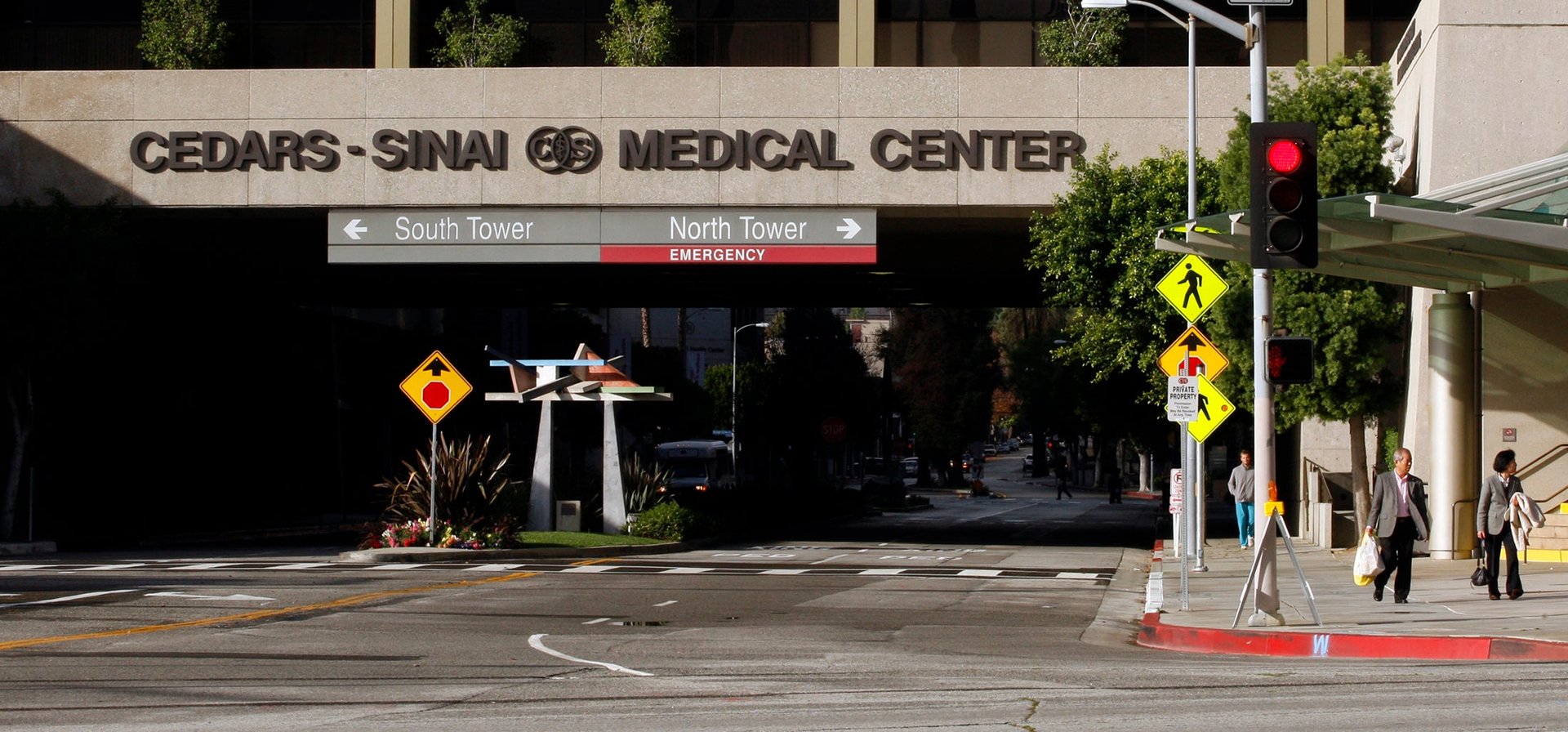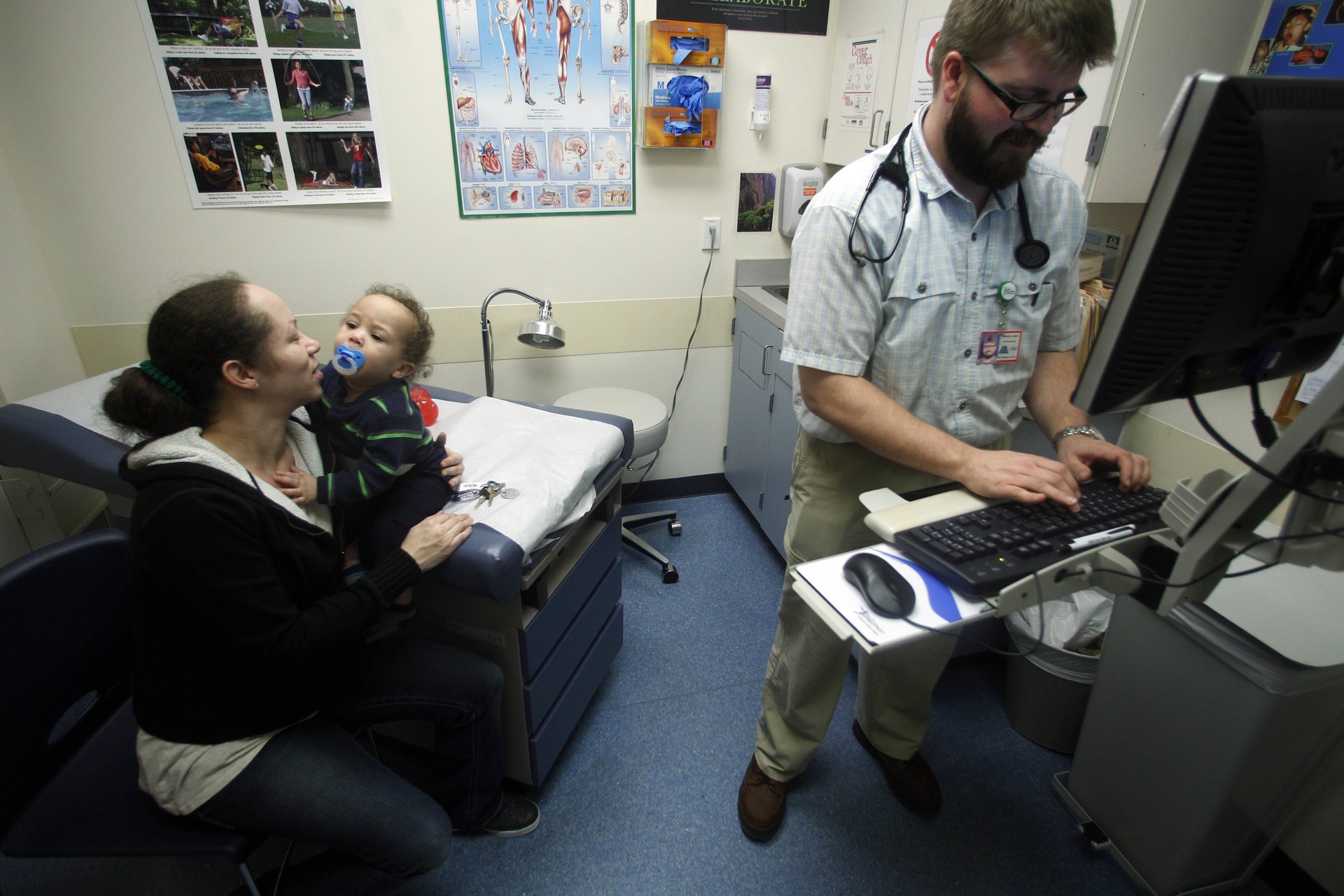Ten questions about mothers’ mental health could promote resilient pregnancies
Angelina Spicer checked herself into a psychiatric hospital about eight months after the birth of her daughter, Ava.


Angelina Spicer checked herself into a psychiatric hospital about eight months after the birth of her daughter, Ava.
When Spicer was about 30 weeks pregnant, doctors at Cedars-Sinai Medical Center in Los Angeles told her that her fetus wasn’t growing normally. Up until that point, she had had a standard, even easy, pregnancy. But when she realized there was a chance that her daughter would die in utero, her anxiety “went through the roof,” she says.
Spicer’s worst fears didn’t come to pass, and she delivered her daughter on May 23, 2015 at Cedars. But Ava continued to have health issues, including colic. Spicer was severely sleep-deprived, and spent most of her time shuffling from one doctor’s appointment to the next. “I felt like I was being tortured,” she wrote in an email. “The possibility of getting sleep was actually the reason I agreed to check into the psych hospital. I thought I’d be left alone to get some rest without having to think about when the next feed would be, or if my baby was still breathing.”
Before she became pregnant, Spicer had been seeing a therapist for about six years, and continued seeing her once a week throughout her pregnancy and postpartum months. So when Spicer started having intrusive thoughts, the therapist was the first to realize something was really wrong. In February 2016, she diagnosed Spicer with postpartum depression and recommended that she check herself into a psychiatric hospital for 10 days.
Women are more likely to develop symptoms of depression during the first year after childbirth than at any other time in their lives (pdf). But at the time of Spicer’s pregnancy, in spite of a hospital-wide policy mandating mental health screening for every patient upon admission, fewer than 10% of new mothers at Cedars-Sinai were being screened for depression.

As soon as clinical psychologist Eynav Accortt joined Cedars-Sinai in July 2015 as an assistant professor in the OB-GYN department, she realized the hospital’s screening process wasn’t working for pregnant women. An estimated 13.9% of mothers in Los Angeles experience symptoms of depression—such as feeling sad, empty, or depressed for most of the day and losing interest in most things they usually enjoyed—while they are pregnant, and 13.6% do during the two weeks or longer after their delivery. And yet fewer than 1% of the nearly 7,000 women who delivered babies at Cedars-Sinai every year were screening positive for depression.
At Cedars, “I never had any kind of screening,” Spicer says. “After I delivered my daughter and clearly expressed to my OB-GYN that I wasn’t feeling well, she never asked me about my mental health. At my six week checkup, same thing. It was just a very light and fluffy conversation.”
Recognizing that experiences like Spicer’s weren’t uncommon, Accortt and Sarah Kilpatrick, chair of Cedars’ Department of Obstetrics and Gynecology, brought together OB-GYNs, nurses, psychiatrists, and social workers in August 2016 to design the Postpartum Depression Screening, Education, and Referral Program. It launched in Cedars’ postpartum unit in April 2017, with the goal of training nurses to screen all women for depression after they’d given birth, educating all patients about perinatal mood and anxiety disorders, or PMADs, and then referring them to in-house social workers if they screened positive.
It was too late to catch Spicer’s case. But by June 2018, 99% of new mothers at Cedars-Sinai were being screened for postpartum depression, making the hospital one of the first in the US to screen all patients, no matter which department admitted them. New mothers were one of the groups to benefit most from this policy, which followed the recommendation of major public health bodies like the US Preventive Services Task Force and the American College of Obstetricians and Gynecologists.
Today, Spicer advocates at the state and national level for universal mental health screenings. Research shows that mothers who screen positive for PMADs are more likely to seek out counseling, which can help prevent or reduce their symptoms and build their resilience.
Universal screening efforts at the state level haven’t always succeeded. Providers need to be trained in how and when to ask the right questions; there needs to be an affordable and accessible system in place to refer women to specialist care if they screen positive; and hospitals need to be incentivized to screen as part of routine care.
The conversation around the value of universal screening, then, is still evolving. But there’s a general acknowledgement that making mental health a regular part of maternal care will better serve patients, their newborns, and their families. “Culturally, there’s this overriding expectation that being pregnant and having a baby is an extremely joyous occasion, and any emotions outside of happiness and excitement are not particularly allowed,” says Teni Davoudian, an assistant professor in psychiatry and OB-GYN at Oregon Health & Science University (OHSU). That could be about to change.
Screening with sensitivity
There are two main tools that healthcare providers use to screen this unique population of patients, and both are straightforward lists of about 10 questions.
The Edinburgh Postnatal Depression Scale (EPDS) asks women how often they have felt a particular emotion in the past seven days, while the Patient Health Questionnaire (PHQ-9) asks similar questions about the past two weeks—things like feeling anxious or worried, having a hard time sleeping, and crying for no apparent reason. Both tools detect depression, but the EPDS has three questions related to anxiety—a condition common in the perinatal period that Accortt says hasn’t received as much attention as depression, but is equally important to diagnose and treat.
Theoretically, any trained healthcare provider can administer a mental health screening. At OHSU, says Davoudian, midwives, family nurse practitioners, primary care physicians, psychiatrists, psychologists, and social workers do it. But administering a depression and anxiety questionnaire to a pregnant or postpartum woman—and doing it well—is not as simple as reading a list of questions off of a sheet paper.
When Accortt first got to Cedars-Sinai, she says nurses were afraid to deliver the PHQ-9 questionnaire because they didn’t know what to do if the women screened positive. “In general [nurses] are all incredibly sympathetic,” she explains. “But they’re also incredibly busy. And for many of them, they have zero nursing training on asking these sorts of questions.”
So Accortt’s team at Cedars-Sinai worked with the nonprofit Maternal Mental Health Now (MMHN) to design a 10-minute training video covering things like what to do if a woman won’t answer questions because she is worried that the nurse might call child protective services, for example. “The timing is important, the tool is important, and the way it is administered is important,” says Accortt.
Accortt is also working to improve how Cedars-Sinai screens and treats black women, who are twice as likely to be depressed during pregnancy as white women in Los Angeles county. (In the US, poor women and women of color are less likely than white women to receive any kind of screening or treatment for PMADs.) In May, MMHN led the launch of a new program called “Improving Outcomes,” with funding from LA Care and Cedars Community Benefit Giving Office. Accortt is the site investigator for the program at Cedars. Medical staff are trained to provide culturally-sensitive treatment to black female patients and their families. So far, approximately 100 Cedars OB-GYNs, nurses, and social workers have been trained. Another part of the program offers psychoeducation and support for pregnant black women who deliver at Cedars.
That kind of attention to detail is critical when screening for PMADs. Reducing someone’s mental state into 10 highly-digestible questions is complicated, and sidestepping the details of a patient’s life could ultimately lead to harm.
Existing screening questionnaires have other flaws. For example, a recent study in Illinois looked at 736 low-income pregnant women who were screened with the EPDS questionnaire. It found that more than a third of the women who answered yes to the question about suicidal ideation did not get a score of 13, the threshold that warrants a clinical referral. This means that screening tools may not be sensitive enough to pick up on even more serious psychological issues than PPD.
There’s also a risk that “we might over-identify people as being depressed,” says Davoudian. “For all of us there are times in our lives that are particularly stressful, and if we take the questionnaire during that time, it’s possible that we might screen positive for depression where it’s really just a brief, situational issue that’s going on.”
During the first few days after childbirth for example, most women experience what’s known as “baby blues.” They may feel sad or anxious, or have trouble sleeping or eating. This is a normal process that comes with adjusting to being a mom, and it usually goes away by itself within two to three weeks. But there is a chance that screenings like the PHQ-9 or EPDS may confuse it for postpartum depression. That’s why Davoudian argues for “ongoing assessment” to “get a sense of what this patient’s baseline is.”
OHSU midwives and OB-GYNs screen women periodically throughout pregnancy and postpartum. But this is expensive and not always possible for smaller hospitals or hospitals that treat patients who move a lot or don’t have time for regular screenings.
Cedars-Sinai screens women once, after they give birth. In some hospitals, argues Sarah Oreck, a reproductive psychiatrist in Los Angeles, the screening process can feel almost robotic. She says too many of her patients fill out screening forms alone while in the waiting room of a hospital, without a face-to-face conversation with a healthcare provider, though even this is better than no screening at all.
The challenge for healthcare providers is to normalize mental health care as part of pregnancy, while providing sufficiently nuanced and individualized care to each patient.
PMADS are common, says Davoudian, “and women should not experience shame about the fact that they do have some dread or some sadness about having a child.” Screening—and screening with sensitivity—“gets us talking about PMADs in the same way that we talk about hemorrhoids, in the same way that we talk about mastitis, or vaginal tears,” says Accortt. “We need to normalize it.”
Screening and resilience
The tide is shifting towards mental health screening as a tool to promote resilient pregnancies. In 2018, California became the fifth US state to require screening for PMADs, along with New Jersey, Illinois, Massachusetts, and West Virginia. Other states require providers to give women information about screenings and about perinatal mental health, but don’t require them to actually do the screenings.
Ideally, mental health care for women in the perinatal period wouldn’t stop there: Women need to be connected with affordable and accessible care so they can get a diagnosis and treatment plan. “Screening alone is completely ineffective and, some would say, immoral or unethical,” argues Accortt. “Because you’re asking the questions and then you’re not doing anything about it.”
Cedars-Sinai is implementing a system whereby, if a woman screens positive for depression, a staff social worker waits a couple of weeks after childbirth and then reaches out to them on the phone or in person to do an additional screening with the EPDS, talk to them about their condition, and see if they followed up on the referral that the hospital’s social workers gave them. The program will launch January 2020.
Once someone gets a diagnosis, they can pursue treatment like cognitive behavioral therapy or specialized care. Unfortunately, however, that is still not very common; currently, only 5% to 14% of women receive treatment for their psychiatric disorders. Undiagnosed PMADs during pregnancy can lead to premature birth and low birth weight, and exacerbate existing mental health disorders.

After pregnancy, PMADs can get in the way of a mother’s bond with her child, who is then more likely to experience cognitive and emotional delays. In hetereosexual couples, research has shown that maternal postpartum depression is correlated with paternal postpartum depression. “That means that oftentimes children are being raised by two depressed parents, which of course is not great,” says Davoudian.
It’s a vicious cycle: A mother’s poor mental health weakens her bond with her loved ones—the same bonds that could help her cope with her anxiety or depression. And while there is a debate about whether screenings alone can get enough women in mental health treatment to move the needle on this issue, it’s clear that, for some women, it can make all the difference. While it is thankfully still rare, perinatal suicidality, which describes any serious thoughts about or attempts at suicide or self-harm, is one of the leading causes of maternal mortality in the first 12 months after birth.
Implementing universal maternal mental health screenings isn’t about making women more resilient at one singular point in their pregnancy. It’s about supporting women at a moment in their lives when that support will most help them, and when they’re most able to receive it. While they’re pregnant and after childbirth, most women get regular checkups with healthcare providers, which makes it possible to reach women from under-represented or particularly vulnerable populations. During this time, pregnant women may “feel more motivated to address ongoing psychological concerns,” says Davoudian, “because they are now going to have a child and their mental health will impact the mental health of their child.” This willingness to change long-held habits or attitudes extends to physical health as well. For example, an oft-cited survey of close to 1,500 UK women found that self-reported smoking decreased from 27% before pregnancy to 15% in early pregnancy.
For activists, mothers are “a bridge to addressing a larger problem that exists for mental health in general,” says Joy Burkhard, executive director of 2020 Mom, a group that advocates for maternal mental health in California. The World Economic Forum estimates that unaddressed mental health problems in the US will cost the world economy around $16 trillion over the next 20 years.
“For some women, this is going to be their first experience with psychotherapy, so it could be their way of dipping their toe in,” says Accortt. “If they find it to be helpful, I think it could be great later on in life when they need to reconnect with mental health, that they feel more comfortable doing so.”
“There’s just so many hoops to jump through.”
In order to foster resilient pregnancies, the US healthcare system needs to invest in better mental health treatment resources and humanize the ways in which women are treated throughout their pregnancies and in the months afterwards—in a word, it needs to be resilient too.
That’s where things get complicated. Psychiatrists are in shortage in the US, especially reproductive psychiatrists like Sarah Oreck, who specialize in treating pregnant women and new moms. And there’s no point connecting vulnerable women with care if the psychiatrist is too far away or doesn’t accept their insurance.
There is a debate, therefore, about whether mandating screening is the best way to improve outcomes for pregnant women and new moms. “Access to psychological and psychiatric care is limited,” says Davoudian, “so we can ask a provider to screen a patient, but if they screen positive for depression and we don’t have anywhere to send them, that puts them in a really difficult situation.”
“It’s not so hard to provide a screening tool to a mom [with] 10 questions to answer,” says Burkhard, whose group lobbied for the bill in California that implemented universal screening, “but it’s the then what … that’s the real elephant in the room. It’s critical that we build up more treatment programs for moms, and until we do that, we’re going to struggle with universal screening.”
Even when care is available, it can be startlingly inconsistent, especially when it comes to the safety of antidepressants for pregnant women and their fetuses. Some doctors refuse to prescribe them, and take women with preexisting mental health conditions off their antidepressants altogether as soon as they become pregnant. But for some women, the risks of depression can outweigh the risks of taking antidepressants. Because there isn’t enough education around perinatal mental health among healthcare practitioners, “women have one physician telling them ‘no, you can’t be on any medication,’ or ‘you can’t be on that medication,’ and then another physician saying ‘yeah, sure, take them,’” says Oreck.
Others worry about the pressure universal screening mandates put on nurses and doctors who are already overworked. Health insurance systems may not be set up to compensate providers and hospitals appropriately for screenings. For example, Cedars-Sinai is paying for their staff social workers’ salaries and training, but it hopes to eventually get insurance companies to take on that cost. In the meantime, even with good health insurance, women often have to pay high copays for therapy and may have a limit on the number of sessions they can take.
“There’s just so many hoops for medical care providers like OB-GYNs and for patients who aren’t well to have to jump through,” says Burkhard. “Our bifurcated mental health and medical systems” don’t help, she adds.
The data are conflicted about whether mandated screening actually benefits new and soon-to-be moms. New Jersey was the first state to require universal perinatal screening in 2006. In 2011, public health researchers looked at more than 30,000 women on Medicaid (pdf) who delivered a baby in New Jersey before and after the bill mandating universal screening passed. Their analysis showed that there was no change in the number of women receiving mental health care in the six months after childbirth and either follow-up or continued care after that. “Although laudable in intent,” it concluded, “these efforts had no measurable effect.”
Some evidence suggests that the same could be true on a national scale. A study published in the journal Psychiatric Services in 2015 reviewed evidence measuring the impact of different types of policies for perinatal mental health, including mandated screening, in 13 states, and found that the evidence was poor-quality. It concluded that “a state-level depression screening mandate alone is unlikely to address peripartum depression.”

Since Cedars-Sinai implemented its Screening, Education, and Referral Program, almost all new mothers are screened for postpartum depression. Accortt says the main increase in positive screenings came after her team developed the video training with MMHN for nurses. The number of women referred to Cedars’ social workers also went up after the video training, from 1.7% to 8.4%. But screen-positive rates continue to hover around 2.5 to 3%—a much lower rate than the general population. Accortt thinks this may be because the PHQ-9 may not be as accurate as the EPDS, and because more nurse training is needed. But the hospital is also testing whether women might be more open in their responses to the questionnaire if the nurse leaves them alone to fill it out on an iPad, thus giving them more privacy.
While there is still progress to be made, Spicer says the hospital and the state have come far since she was a patient at Cedars, silently suffering with untreated depression and anxiety. In the meantime, she is still lobbying Congress for a universal maternal mental health screening mandate that takes into account the experience of vulnerable communities, like women of color and poor women.
“If on a human level, you’re not tapped into what I could be going through, then we’ve got to mandate this,” she says. “Because otherwise you won’t ask, and you didn’t ask.”